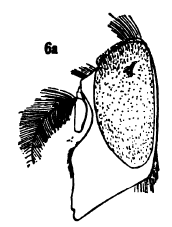| Volucella evecta | |
|---|---|
 | |
| Male head from Williston S.W. | |
| Scientific classification | |
| Domain: | Eukaryota |
| Kingdom: | Animalia |
| Phylum: | Arthropoda |
| Class: | Insecta |
| Order: | Diptera |
| Family: | Syrphidae |
| Genus: | Volucella |
| Species: | V. evecta |
| Binomial name | |
| Volucella evecta Walker, 1852 | |
| Synonyms | |
| |
Volucella evecta, the eastern swiftwing, is an uncommon species of hoverfly that has been considered a subspecies of Volucella bombylans , but has been shown to be a distinct species. This species is a bumblebee mimic. It resembles a number of species, including Bombus pensylvanicus , Bombus affinis , Bombus bimaculatus , and Habropoda laboriosa . [1] The range of this species is from Eastern North America and Canada from Georgia to New Brunswick. The adults have been observed feeding on Geum , Viburnum , Rubus, and other flowering plants. Larvae of this species are not known, but larvae in this genus feed on the debris and larvae in bee and wasp nests. [2]
